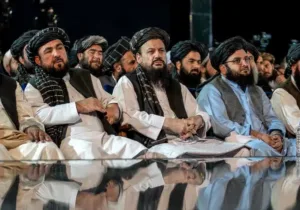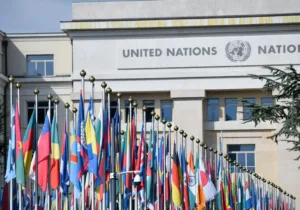Ecumenical Islamist Terror against the West
Iran’s high-order, continuous and intense relationship with terror groups such as Hezbollah, Hamas, Palestinian Islamic Jihad, Hashd Shaabi, and Houthis is well-known. Less known is the link between Islamic Revolutionary Guards Corps-Quds Force (IRGC-QF) and al Qaeda, the terror group that carried out the catastrophic 9/11 attacks against the United States.
Studies of the proxies favor a binary approach to the linkage and assume that a relation between the handler and the proxy exists or does not exist. Such assumptions ignore that the relations between state sponsors and terror groups are spectral, ranging from high-end, full cooperation to low-end collaboration limited to specific goals. In the case of Iran, a Shiite state, the common assumption was that the IRGC-QF does not maintain ties to Sunni jihadi groups. Ignoring such low-end ties had overlooked Iran’s connection with al Qaeda and its senior leaders such as Osama bin Laden, Ayman al Zawahiri (al Qaeda-Central), Abu Musab al Zarqawi’s (al Qaeda in Iraq), and several other senior commanders of the terror group.
The IRGC-QF connection with al Qaeda was essentially low-order, intermittent, patchy, opportunistic, and born out of a common goal of fighting the United States in the Middle East and beyond. However, the connection was hardly recognized until the discovery of the bin Laden documents in his compound in Abbottabad, Pakistan.
This linkage primarily blossomed when bin Laden and thousands of the so-called “Afghan Arabs” had begun to return from Afghanistan in the late 1980s. The IRGC-QF considered this wave of ready-made terrorists a once-in-a-lifetime opportunity.
In another lucky coincidence, General Omar Bashir, who came to power in Sudan in 1989, allied with the veteran Islamist activist and theologian Hassan al Turabi, who turned Sudan into a center for a global anti-Western jihad movement. Al Turabi headed the Islamic National Front (INF) and was a long-time advocate of Shiite-Sunni collaboration (taqrib). Married to the daughter of Abdullah Azzam – the father of modern Islamic terrorism – al Turabi was acquainted with bin Laden and Zawahiri, the then head of the Egyptian Islamic Jihad (EIJ), and Sheikh Omar Abdul Rahman (the blind Sheikh), the chief of Jamaa Islamiyah (JI).
For Iran, Sudan offered an unprecedented opportunity on several levels. IRGC-QF was keenly interested in housing and retraining returning jihadists; a prospect made easier when bin Laden relocated to Khartoum in 1991. Geopolitically, Sudan’s location in the Horn of Africa offered a bridge to the waterway between the Red Sea and the Indian Ocean and access to several Muslim countries in black Africa, the Maghreb, and Europe.
Eager to build the terror infrastructure, Iran concluded several economic and security agreements with the Sudanese government. In exchange for considerable investment in the impoverished country and discount oil, the IRGC-QF obtained the rights to build training camps for a broad spectrum of terrorists from more than a dozen countries.
Guided by al-Turabi and Zawahiri, who had good relations with the Quds Force chief Ahmad Vahidi, the IRGC-QF formed a mutely profitable alliance with bin Laden. Bin Laden, who, like the Iranians, invested in the Sudanese economy, needed help with the training of the Afghan alums housed in several of his farms-turned-camps. The IRGC-QF planned to use the militants to foment unrest in the Gulf region and Yemen. To this end, the IRGC signed a formal agreement with bin Laden in 1992, and they agreed to IRGC-QF overseeing camps such as al Khadolf, al Grif, al Shabat, and scores of others.
The failed state of Somalia offered the IRGC-QF a perfect opportunity to road-test their new terrorist infrastructure. In 1992, al-Turabi and the IRGC-QF organized the Somali Islamic Union Party (SIUP), a coalition of several radical tribal groups to fight the Americans. The IRGC-QF also founded and trained the Somali Revolutionary Guard (SRG). Bin Laden followed up with a base in the Ogaden region between Somalia and Ethiopia. Volunteers from several Arab countries arrived to answer the call to jihad, including the Iraqi-based Movement of Vanguard Mission.
Helped by a contingent of al Qaeda’s Afghan Arabs and IRGC-QF commanders, the Somali militants inflicted heavy causalities on the United Nations Operation in Somalia (UNOSOM) forces. The American military raided Mohammad Aidid’s (one of the civil war warlords) compounds, generating more firefights, including the devastating “Black Hawk Down” incident in Mogadishu, which resulted in the withdrawal of US forces from Somalia.
For the IRGC-QF, the American retreat from Somalia confirmed the successful proxy strategy. In a broader sense, the failed peacekeeping excursion had prompted Washington’s aversion to “foreign adventures,” which lasted until 9/11.
With the triumph in Somalia still fresh, the IRGC-QF turned its attention to regime change in Egypt. Reviled for the peace treaty with Israel, the Egyptian regime was high on the IRGC-QF’s destabilization and regime change agenda. Zawahiri was at the forefront of this effort. After several assassination attempts on Egyptian officials in 1995, militants from the PIJ and Egyptian Islamic Jihad (EIJ) tried to assassinate President Hosni Mubarak during his visit to Ethiopia. Mubarak’s close encounter with disaster finally persuaded the Clinton administration to move against al Qaeda. Washington pressured Sudan to expel al Qaeda, and bin Laden and Zawahiri decamped to Afghanistan.
The departure of the al Qaeda chiefs was a setback for the IRGC-QF, which planned to mount more attacks against Saudi Arabia, such as the explosion in Khobar Towers, which killed 17 American servicemembers. The FBI and the Saudi authorities who investigated the case found that the attack was a joint effort of al Qaeda, the Lebanese Hezbollah, and Hezbollah Hejaz, a violent Saudi militant cell backed by the IRGC-QF.
In Afghanistan, bin Laden allied with the Taliban, a group hostile to Iran and its Afghan Shiite allies. Still, the IRGC-QF decided to keep the low-end contacts to maintain control in Afghanistan and allowed al Qaeda to retain some of its privileges, including unhindered transit of its fighters through Iran.
In 2000, the IRGC-QF helped Zarqawi, an “independent contractor” of bin Laden, to set up a training camp near Herat, close to the Iranian border. Zarqawi used the base to train fighters from the Tawhid Wal Jihad, a militia he had established in Jordan. In the same year, the IRGC-QF was implicated in bin Laden’s attack on USS Cole in Yemen. A court in the United States found that the IRGC-QF helped al Qaeda by setting up a terror network in Yemen.
When the U.S. invaded Afghanistan, Qasem Suleimani, the commander of the IRGC-QF, executed an ‘exfiltration project’ and moved several members of the bin Laden family and some top al Qaeda commanders to Iran, where they plotted attacks on Americans in the Middle East. The 9/11 commission recommended a further investigation of the relationship, but the full scope of the ties was not realized until the US seized bin Laden’s computers.
When the Reformist Mohammed Khatami came to power in Iran as President, he ordered al Qaeda members to be deported from Iran. Still, Suleimani found ways to get around the government. Suleimani expelled some of the rank-and-file al Qaeda members in a public show of compliance. Still, several other senior operatives and the bin Laden family were moved around the country to hide. Several hundred members, including Zarqawi, who established al Qaeda in Iraq (AQI), were exfiltrated to Iraq in preparation for the American invasion.
According to some intelligence sources, the IRGC-QF supplied Zarqawi with automatic weapons, IEDs, ammunition, uniforms, and even real Iranian passports for his frequent recruitment trips. When Zarqawi moved to the Sunni Triangle, he mounted a vicious campaign against the Shiites. However, the IRGC-QF did not abandon its lower-order contacts with him because Zarqawi engaged in brutal attacks against Americans, and his cost-benefit ledger in the IRGC-QF calculus balanced out.
Those al Qaeda senior leaders who remained inside Iran enjoyed a life free from the threat of drone strikes with only minor restrictions. Among them were bin Laden’s son, Hamza, and Abu Muhammad al-Masri, al Qaeda’s second in command, who was killed in August 2020 by Israeli special forces in Tehran. Saif al-Adel, (Zawahiri’s deputy) and his media operations head Abd al-Rehman al-Maghribi, are currently living in Iran.
Similarly, Zawahiri, the head of al Qaeda Central, who was killed on August 1, 2022, by an American drone in Kabul, spent a considerable time in Iran after he went into hiding following the Operation Enduring Freedom in 2002. Now, with Zawahiri’s elimination, many expect Saif al-Adel to lead al Qaeda moving forward.
Having harbored Zawahiri and al Adel, the Iranian regime stands to increase its influence among the broadly dispersed units of the terror group, which still subscribe to Osama bin Laden’s vision of waging war on the West.







 Sponsor a student for Christianity & National Security 2024
Sponsor a student for Christianity & National Security 2024